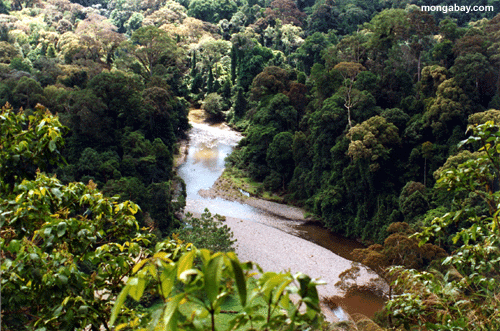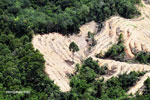Baby orangutan in Sabah, Malaysia. Photo by Rhett A. Butler. |
On Saturday Prince William and his wife Catherine Middleton visited Danum Valley Conservation Area in Sabah, Malaysia as part of the Queen’s diamond jubilee celebrations. In so doing, the royal couple saw one of the last surviving tracts of relatively pristine lowland rainforest in Borneo.
Danum Valley is located in northeastern Borneo, a region recognized for its high levels of biodiversity, including well-known wildlife species like elephants, orangutans, and rhinos. Much of Danum was once once zoned for logging, but unlike most of Sabah, today the forest is in good shape, including tracts of ancient trees.
 Imbak Canyon, an area of virgin rainforest not far from Danum Valley. Photo by Rhett A. Butler.  Danum Valley rainforest. Photo by Rhett A. Butler. |
While more than 50 percent of Sabah is covered with forest, less than 5 percent is considered old-growth. Most of the state’s forests have been heavily logged, while more than 1.4 million hectares—nearly a fifth of Sabah’s land mass—has been converted for oil palm plantations.
Logging in Sabah peaked between the early 1970s and the mid-1990s, before collapsing around 2000 due to overexploitation. Sabah wasn’t alone in its devastation of rainforests — the forests in both Indonesian Borneo and neighboring Sarawak, which is also part of Malaysia, have also been decimated. On Borneo, only Brunei’s forests remain relatively intact.
 Logging road in Sabah.  Clearing of hillsides for oil palm in Sabah.  Heavily logged forest in Sabah. All photos by Rhett A. Butler. |
Deforestation in Sabah has dropped significantly in recent years and the state has set aside several important protected areas, but logging remains controversial. In August Sabah’s chief minister Musa Aman was named in a corruption investigation launched by Swiss authorities. Musa and his associates allegedly sold off logging concessions and funneled the proceeds into accounts held at the Swiss bank, UBS. While Musa has denied the charges, he was also the subject of an investigation by Malaysia’s anti-corruption agency.
Given Musa’s alleged linked to timber corruption, some human rights groups and environmental organizations called for William and Kate to boycott the minister during their visit. The royals nonetheless met with Musa and other dignitaries before flying off to the Solomon Islands.
William’s visit to the rainforest isn’t the first for the royal family. William’s father, Prince Charles, is a vocal advocate for rainforest conservation. The Prince’s Rainforest Project has pushed for a huge scaling-up of rainforest funding by tying the services afforded by healthy forests — like climate change mitigation and provision of rainfall — to global finance. The initiative has also sought to reduce the environmental impact of commodity production, which is the chief driver of deforestation.
Danum Valley Conservation Area
Red Leaf-monkey (Presbytis rubicunda)

Clipper butterfly (Parthenos sylvia)
Green Crested Lizard high in the rainforest canopy
Mist rising from the Borneo rainforest
Danum Valley canopy walkway
Related articles
Industrial logging leaves a poor legacy in Borneo’s rainforests

(07/17/2012) For most people “Borneo” conjures up an image of a wild and distant land of rainforests, exotic beasts, and nomadic tribes. But that place increasingly exists only in one’s imagination, for the forests of world’s third largest island have been rapidly and relentlessly logged, burned, and bulldozed in recent decades, leaving only a sliver of its once magnificent forests intact. Flying over Sabah, a Malaysian state that covers about 10 percent of Borneo, the damage is clear. Oil palm plantations have metastasized across the landscape. Where forest remains, it is usually degraded. Rivers flow brown with mud.
Charts: deforestation in Indonesia and Malaysia, 2000-2010

(07/15/2012) Indonesia and Malaysia lost more than 11 million hectares (42,470 square miles) of forest between 2000 and 2010, according to a study published last year in the journal Global Change Biology. The area is roughly the size of Denmark or the state of Virginia. The bulk of forest loss occurred in lowland forests, which declined by 7.8 million hectares or 11 percent on 2000 cover. Peat swamp forests lost the highest percentage of cover, declining 19.7 percent. Lowland forests have historically been first targeted by loggers before being converted for agriculture. Peatlands are increasingly converted for industrial oil palm estates and pulp and paper plantations.
In pictures: Rainforests to palm oil

(07/02/2012) In late May I had the opportunity to fly from Kota Kinabalu in Malaysian Borneo to Imbak Canyon and back. These are some of my photos. Historically Borneo was covered by a range of habitats, including dense tropical rainforests, swampy peatlands, and natural grasslands. But its lowland forests have been aggressively logged for timber and then converted for oil palm plantations.